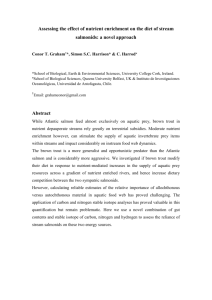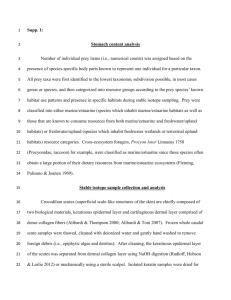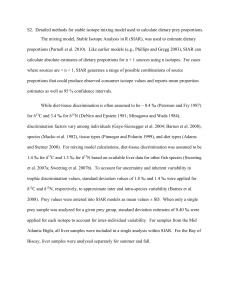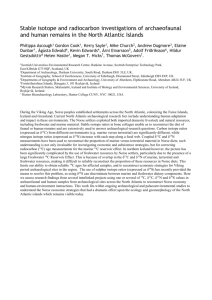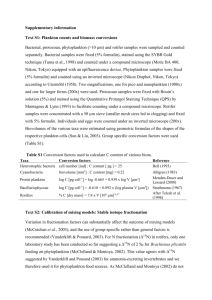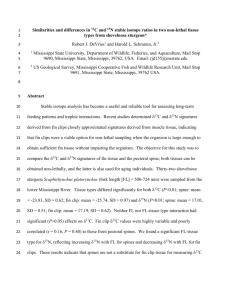jane12208-sup-0002-AppendixS2-FigS2
advertisement
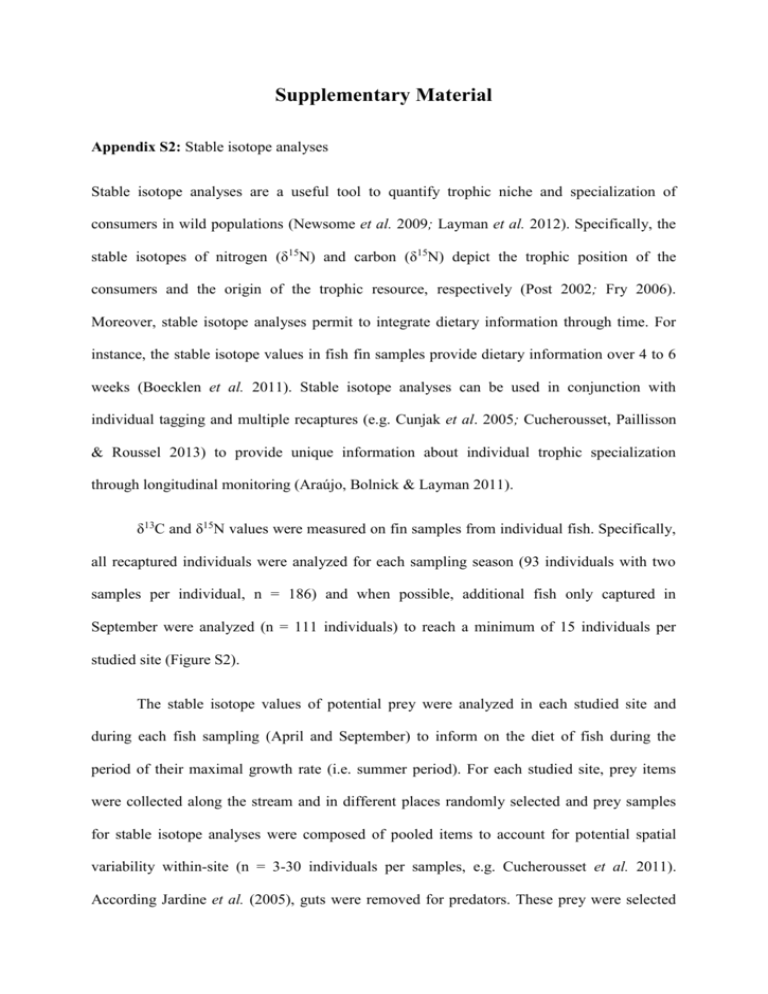
Supplementary Material Appendix S2: Stable isotope analyses Stable isotope analyses are a useful tool to quantify trophic niche and specialization of consumers in wild populations (Newsome et al. 2009; Layman et al. 2012). Specifically, the stable isotopes of nitrogen (δ15N) and carbon (δ15N) depict the trophic position of the consumers and the origin of the trophic resource, respectively (Post 2002; Fry 2006). Moreover, stable isotope analyses permit to integrate dietary information through time. For instance, the stable isotope values in fish fin samples provide dietary information over 4 to 6 weeks (Boecklen et al. 2011). Stable isotope analyses can be used in conjunction with individual tagging and multiple recaptures (e.g. Cunjak et al. 2005; Cucherousset, Paillisson & Roussel 2013) to provide unique information about individual trophic specialization through longitudinal monitoring (Araújo, Bolnick & Layman 2011). δ13C and δ15N values were measured on fin samples from individual fish. Specifically, all recaptured individuals were analyzed for each sampling season (93 individuals with two samples per individual, n = 186) and when possible, additional fish only captured in September were analyzed (n = 111 individuals) to reach a minimum of 15 individuals per studied site (Figure S2). The stable isotope values of potential prey were analyzed in each studied site and during each fish sampling (April and September) to inform on the diet of fish during the period of their maximal growth rate (i.e. summer period). For each studied site, prey items were collected along the stream and in different places randomly selected and prey samples for stable isotope analyses were composed of pooled items to account for potential spatial variability within-site (n = 3-30 individuals per samples, e.g. Cucherousset et al. 2011). According Jardine et al. (2005), guts were removed for predators. These prey were selected according to their abundance in the sites, identified to the lowest possible taxon and finally categorized into five trophic groups: aquatic herbivore (Glossosomatidae, Heptageneidae), aquatic predators (Perlidae), aquatic detritivores (Gammaridae, Nemouridae, Sericostomatidae), terrestrial herbivores (Orthoptera, Coleoptera) and terrestrial predators (Aranea, Diptera). Following the recommendations of Philips, Newsome & Gregg (2005), this procedure was performed to obtain functionally and isotopically coherent isotopic groups to reduced the number of putative prey in mixing models. This was confirmed by the facts that functional groups did not overlap in the 2-D isotopic space (Figure S2) and that, for each season and each site, between-group variability of prey stable isotope values (δ13C and δ15N) was much higher than the within-group variability (April: meaninter δ13C = 83.07% (± 6.72 SE), meanintra δ13C = 16.93% (± 6.72 SE), meaninter δ15N = 79.60% (± 3.51 SE), meanintra δ15N = 20.40% (± 3.51 SE); September: meaninter δ13C = 83.74% (± 6.28 SE), meanintra δ13C = 16.26% (± 6.28 SE), meaninter δ15N = 80.46% (± 2.75 SE), meanintra δ15N = 19.54% (± 2.75 SE). Therefore, these functional and isotopic groups were used for subsequent analyses and within-group variability was incorporated in the mixing models (Parnell et al. 2010). Since the C:N ratio of prey were upper (aquatic herbivore: mean = 9.31 ± 0.95 SE; aquatic predators: 4.05 ± 0.05; aquatic detritivores: 5.97 ± 0.12; terrestrial herbivores: 4.89 ± 0.15; terrestrial predators: 4.48 ± 0.13) than the suggested limits (3.5 and 4 for aquatic and terrestrial organisms, respectively; Post et al. 2007), the stable isotope values of prey were lipid-corrected following Post et al. (2007). The mean magnitude of lipid corrections in April and in September for aquatic herbivores, aquatic predators, aquatic detritivores, terrestrial herbivores and terrestrial predators are 1.33 (± 0.06 SE), 0.65 (± 0.06), 2.76 (± 0.11), 1.51 (± 0.18), 0.90 (± 0.14) and 1.08 (± 0.06), 0.72 (± 0.07), 2.44 (± 0.23), 1.56 (± 0.17), 1.11 (± 0.19), respectively. No significant differences in δ13C lipid correction between sites were observed (ANOVAs, F < 3.33, P > 0.05). Prior to analyses, all stable isotope samples were oven-dried at 60°C for 48h and subsequently analyzed at the Cornell Isotope Laboratory (COIL, Ithaca, New York, USA). The analytical precision for all samples, calculated as the standard deviation of an internal Mink standard, was 0.15 and 0.27 ‰ for δ13C and δ15N, respectively. Streams are composed of mixed carbon source (terrestrial plant litter vs autochthonous primary producers) with distinct isotopic signature (13C-depleted and 13 C-enriched, respectively, Hoeinghaus & Zeug 2008). Therefore, the δ13C values of aquatic prey should change in response to canopy openness. Consequently, the δ13C range of aquatic prey was calculated using the difference between the maximum and the minimum δ13C values of aquatic detritivores, herbivores and predators (Layman et al. 2007). As expected, a significant hump-shaped curve was found between the δ13C rage of aquatic prey and the gradient of canopy openness (R² = 0.52, linear term: P = 0.029, quadratic term: P = 0.032), indicating that carbon source used by aquatic prey in intermediate site were more diverse than in extreme sites. Cited references Araújo, M.S., Bolnick, D.I. & Layman, C.A. (2011) The ecological causes of individual specialization. Ecology Letters, 14, 948–958. Boecklen, W.J., Yarnes, C.T., Cook, B.A. & James, A.C. (2011) On the use of stable isotopes in trophic ecology. Annual Review of Ecology, Evolution, and Systematics, 42, 411–440. Cucherousset, J., Acou, A., Blanchet, S., Britton, J.R., Beaumont, W.R.C. & Gozlan, R.E. (2011) Fitness consequences of individual specialization in resource use and trophic morphology in European eels. Oecologia, 167, 75–84. Cucherousset, J., Paillisson, J.-M. & Roussel, J.-M. (2013) Natal departure timing from spatially varying environments is dependent of individual ontogenetic status. Naturwissenschaften, 100, 761– 768. Cunjak, R.A., Roussel, J-M., Gray, M.A., Dietrich, J.P., Catwright, D.F., Munkittrick, K.R. & Jardine, T.D. (2005) Using stable isotope analysis with telemetry or mark-recapture data to identify fish movement and foraging. Oecologia, 144, 636–646. Fry, B. (2006) Stable Isotope Ecology. Springer. Hoeinghaus, D.J. & Zeug, S.C. (2008) Can stable isotope ratios provide for community-wide measures of trophic structure? Comment. Ecology, 89, 2353–2357. Jardine, T.D., Curry, R.A., Heard, K.S. & Cunjak, R.A. (2005) High fidelity: isotopic relationship between stream invertebrates and their gut contents. Journal of the North American Benthological Society, 24, 290–299. Layman, C.A., Arrington, D.A., Montaña, C.G. & Post, D.M. (2007) Can stable isotope ratios provide for community-wide measures of trophic structure? Ecology, 88, 42–48 Layman, C.A., Araújo, M.S., Boucek, R., Hammerschlag-Peyer, C.M., Harrison, E., Jud, Z.R., Matich, P., Rosenblatt, A.E., Vaudo, J.J., Yeager, L.A., Post, D.M. & Bearhops, S. (2012) Applying stable isotopes to examine food-web structure: an overview of analytical tools. Biological Reviews, 87, 545–562. Newsome, S.D., Tinker, M.T., Monson, D.H., Oftedal, O.T., Ralls, K., Staedler, M.M., Fogel, M.K. & Estes, J.A. (2009) Using stable isotopes to investigate individual diet specialization in California sea otters (Enhydra lutris nereis). Ecology, 90, 961–974. Parnell, A.C., Inger, R., Bearhop, S. & Jackson, A.L. (2010) Source partitioning using stable isotopes: coping with too much variation. PLoS One, 5, e9672. Phillips, D.L., Newsome, S.D. & Gregg, J.W. (2005) Combining sources in stable isotope mixing models: alternative methods. Oecologia, 144, 520–527. Post, D.M. (2002) Using stable isotopes to estimate trophic position: models, methods, and assumptions. Ecology, 83, 703–718. Post, D.M., Layman, C.A., Arrington, D.A., Takimoto, G., Quattrochi, J. & Montaña, C.G. (2007) Getting to the fat of the matter: models, methods and assumptions for dealing with lipids in stable isotope analyses. Oecologia, 152, 179–189. Aquatic predators Aquatic herbivores September April 7 (a) 7 5 MOUS 5 (b) 3 3 1 c p a h -1 p s c p 1 -1 a a h s s n ga gl n -3 -3 ga gl n ga i -5 -5 -29 -27 Terrestrial predators Terrestrial herbivores Aquatic detritivores -25 -23 -29 -21 7 (c) 7 5 FRAI 5 -27 -25 -23 (d) d c c 3 p 3 p h 1 a s a -1 ga n s s a gl -3 n ga n ga -3 -30 δ15N p h h 1 gl -1 -21 -28 -26 -24 -22 -30 6 (e) 6 4 PESQ 4 -2 p h gl s h ga -2 a a s m m n -22 p 0 m gl -24 (f) a h 0 -26 2 p 2 -28 n ga ga n -4 -4 -31 -29 -27 -25 -31 -23 9 9 (g) 7 LAMP -29 -27 -25 -23 (h) d 7 5 5 3 3 a 1 p h -1 ga c s s h n n -3 gl a p h -1 s n -3 a p 1 c ga gl ga -5 -5 -33 -31 6 (i) 4 PEYR -29 -27 -25 6 -31 -29 -25 -23 p 2 p a h s h d n -2 m -4 -28 -26 -24 -22 ga n ga m -4 -30 s s gl ga n a a h 0 gl -2 -32 -27 (j) 4 p 2 0 -33 -23 -32 δ13C -30 -28 -26 -24 -22 Aquatic predators Aquatic herbivores Terrestrial predators Terrestrial herbivores Aquatic detritivores September April 9 (k) 9 7 ORBI 7 (l) p h 5 5 p h 3 a p h 3 gl 1 gl 1 ga n -1 a a d n ga n ga -1 or or -3 -3 -34 6 4 -30 -26 -22 -34 (m) 6 BRG1 4 p 2 -30 -26 -22 (n) 2 p p a a a 0 0 s -2 m n gl or -2 ga ga m n gl ga -4 -4 -34 -30 -26 -34 -22 7 (o) 7 5 LINO 5 3 δ15N h h h -30 3 -1 -3 h gl -1 -ga n gl p p a 1 s h -22 d a p 1 -26 (p) s h n a s n ga ga -3 or or -5 -5 -37 -33 -29 -25 -21 -37 7 (q) 7 5 BRG2 5 -33 -29 p 1 h s -1 p a p 1 gl -3 a a h h s or gl -1 ga n ga s n n ga -3 or -21 (r) 3 3 -25 or -5 -5 -32 -30 -28 -26 -24 -32 -22 6 (s) 6 4 BERN 4 -30 -28 c p 0 s h -2 p -4 p s d n -2 gl n -22 a 2 c 0 -24 (t) a a 2 -26 s h h gl n -4 -28 -26 -24 -22 -28 -26 -24 -22 δ13C Figure S2: δ13C and δ15N values of individual fish (diamonds) and putative prey (circles) analyzed in April (left panels) and September (right panels) in the ten studied stream sites: MOUS (a, b), FRAI (c, d), PESQ (e, f), LAMP (g, h), PEYR (i, j), ORBI (k, l), BRG1 (m, n), LINO (o, p), BRG2 (q, r) and BERN (s, t). Open diamonds represent individuals tagged in April and recaptured in September while black diamonds represent additional individuals sampled in September. Small circles represent single prey composed of pooled items (n = 3 – 30 individuals). Large circles represent prey trophic groups (mean ± SE): aquatic herbivores (gl: Glossosomatidae, h: Heptageneidae), aquatic predators (p: Perlidae), aquatic detritivores (ga: Gammaridae, n: Nemouridae, s: Sericostomatidae), terrestrial herbivores (c: Coleoptera, or: Orthoptera, m: mixed) and terrestrial predators (a: Aranea, d: Diptera).
